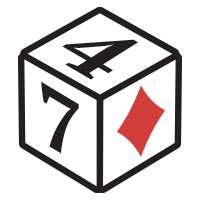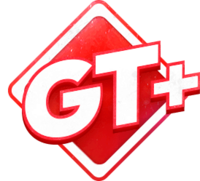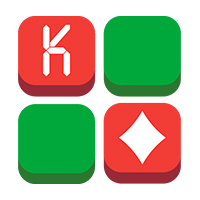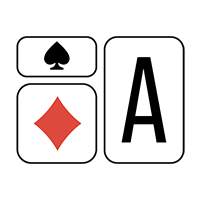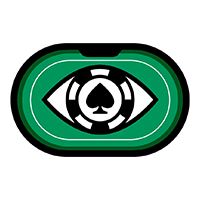In today's video we'll be going over a session I recently played on CoinPoker at $1/$2 and $2.5/$5.
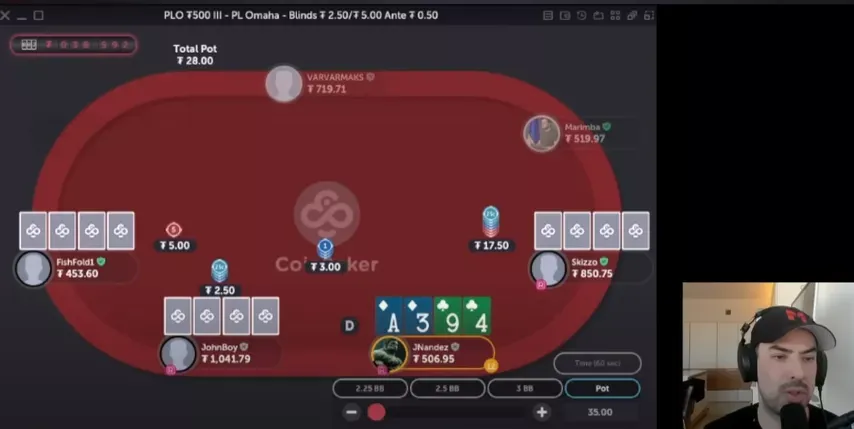
The cutoff makes a raise that looks standard, but it's not the full pot – we're playing with an ante, so the max raise is higher. The difference in sizing affects our preflop – with better pot odds we can play more hands.
We have a preflop simulation for the game with an ante on our PLO Mastermind website, but with a slightly different structure – the ante is 1.5 blinds, which is significantly higher than on Coin Poker, but also with a higher rake. I’ll note right away that because of the big antes, the cutoff has an open limp in his arsenal! And after a raise, the button can call with 28% of hands – that’s a lot! (3-bet is made with 7% of hands, this number is more standard.) For comparison, on PL50 with the PokerStars structure, the button can call with only 9% of hands.
When playing with an ante, calling with A943ds becomes mandatory and quite profitable – it brings 0.19bb per hand. Folding would be a big mistake. Without an ante, it’s a standard fold, calling with this hand loses a little more than 0.2bb.
When watching training videos, keep in mind that the environment you play in may be different, so learn preflop from proper simulations, not from the actions of the instructors.
BB calls, we see the flop three at a time.
Flop ($55.10):
We get two checks. It's time to ask ourselves, which action will bring us more EV – checking or betting? To answer this question, we need to compare two scenarios. Of course, our hand itself is not impressive, but we have a four-hit and a crucial straight blocker – a nine (critical because it is included in both open-ended straight draws: And ). Because of the nine, our fold equity increases.
On the other side of the scale is a free card. How useful can it be to us? It depends on how many good turns our hand has. An ace, for example, against two people will not give us a strong enough combination, not to mention a nine or a three.
We can't see in PLO Trainer what the solver does with our hand, since our flops are calculated for a game without an ante, but we can take a hand similar in overall composition, for example, or . With both of these hands, the solver always bets half the pot. Probably with ours too. should be put.
Are there any hands containing , who don't bet the flop? Yes – you need, for example, a queen: it gives a nut gutshot, which increases the value of a check.
During the game I was not sure about the assessment and eventually checked after, made a mistake. I did not have enough practice – I returned to the tables after a two-week trip to Europe. Lost my form!
Turn ($55.10):
A flush draw came, but unfortunately not the nuts – only to nine. The BB bets $44.91. The cutoff folds. A big bet! Obviously, a call here does not print money, but is it better than a fold, better than zero?
I think it's obvious what will happen. But for the video I still calculated the situation in Monker, manually setting the BB bet sizing and the A943ds hand in my range. The call turned out to be profitable, with an expectation of about 1.8bb. A tiny fraction of the total pot, but no big deal, because the main thing is to have EV above zero.
I called.
River ($142.54):
The opponent checks.
Nine doesn't help our range much – with many wraps and nut gutshots we'd be betting the flop. As for our hand, second pair allows us to beat some hands that led the turn at showdown.
The calculation in Monker confirms the conclusion that the check next is the optimal solution.
I checked and my opponent took the pot with a set of deuces, By the way, it’s not bad to lead with his hand from the BB already on the flop: he has two pairs (good blockers!), but it’s not very pleasant to play check-call because of the pair in the hand, and check-raise is a clear overplay.
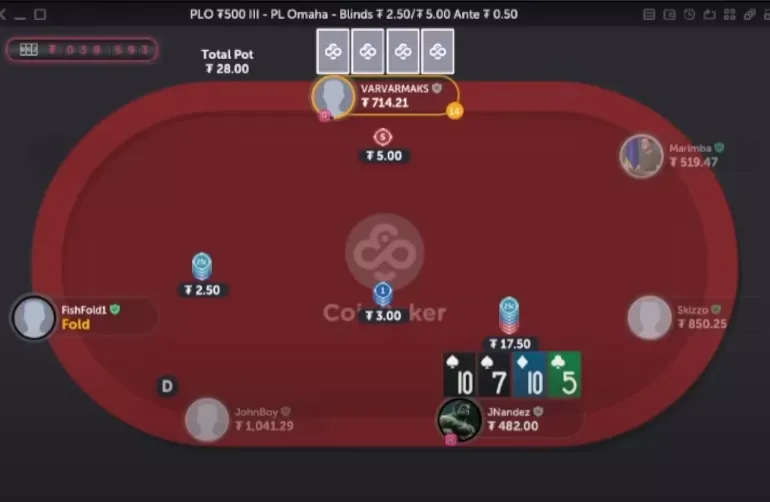
In the next hand we open TT75ss from the cutoff. With big antes, it's better to limp with hands like this. In general, with any antes, we should be entering hands more often.
Only the big blind calls.
Flop ($38.47):
The opponent checks.
We didn't really flop anything, we need to choose between betting and checking. How valuable is a free card to us? We have a bottom gutshot and a pair of tens, which, if improved to a set, will put several straights on the board. Obviously, there is no value in this. And since we have good blockers, we should not check, but bluff. Two tens are very powerful blockers, relevant on many textures. In addition, we even have a diamond! Given all this, the bluff should be just great.
PLO Trainer doesn't have this exact texture, so let's look at , and I will share my train of thought, which is more useful than copying the solver. On this texture I look at the hand without a straight flush draw and I see that they all bet 3/4 of the pot.
With a stronger straight draw, for example, , the value of the check increases.
In general, we always think about blockers and equity, and the correct strategy usually becomes clear.
In this hand we bet 3/4 and the opponent folded.
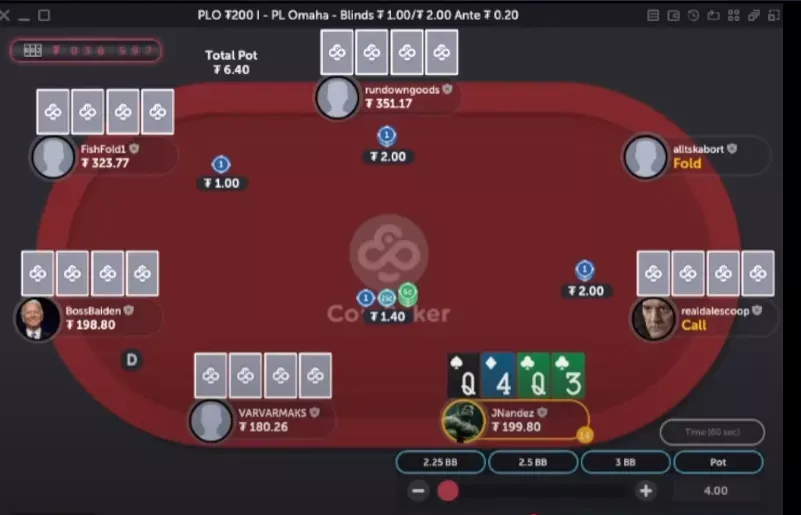
Here we get a limp (the game is still with an ante). I decide to fold, since there are several players in position behind me. Alas – a mistake!
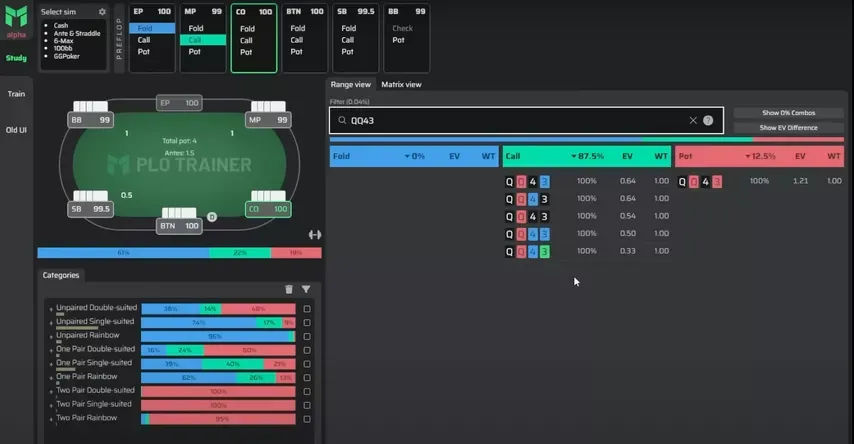
This was a very profitable overlimp. Okay, the ante is higher in this simulation, but when the win rate is that high, it's clear that even with our antes the expectation of calling is much higher than zero.
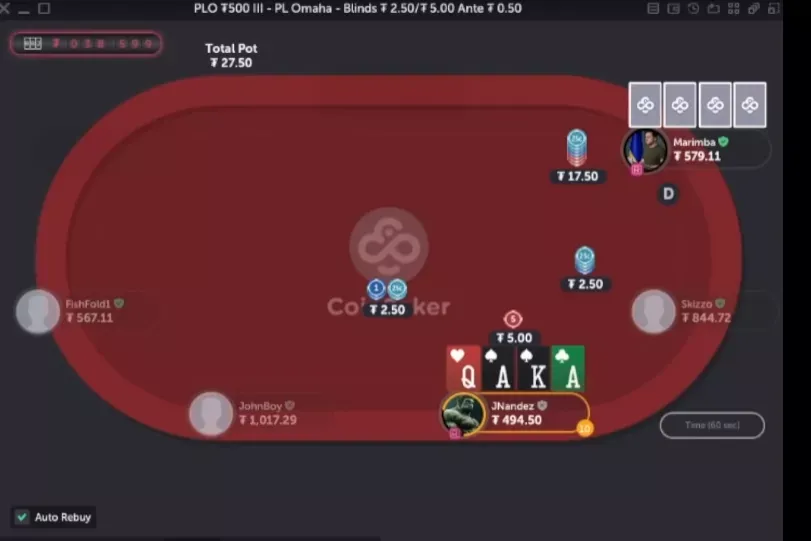
With good aces we 3-bet from BB against button. Effective stack is 100bb. Opponent calls.
Flop ($110):
We don't have a flush draw, nor do we have a single diamond blocker, but we do have a nut straight. The board, however, is not one where we c-bet with everything – we'll be checking about half our range on this texture. It's clear that without redraw feel very bad here, but with It's not very comfortable to bet – what are we going to do about the raise?
And with ours too without a flush draw, the advantage against the calling range is not very big. And if we get raised, it's even worse – we can get against a set with a flush draw (and go noticeably lower), and against the same straight with a flush draw, which is really sad.
So the first step is to make sure it's not a range bet texture, the second is to think about the playability of your hand. I ended up deciding that checking looks better. According to the solver, c-betting and checking are equally good for our hand.
My opponent bets $36.30 on my check, giving us the option to check-raise. If we raise the pot, we'll essentially be done with the flop, which is great for a hand with poor playability.
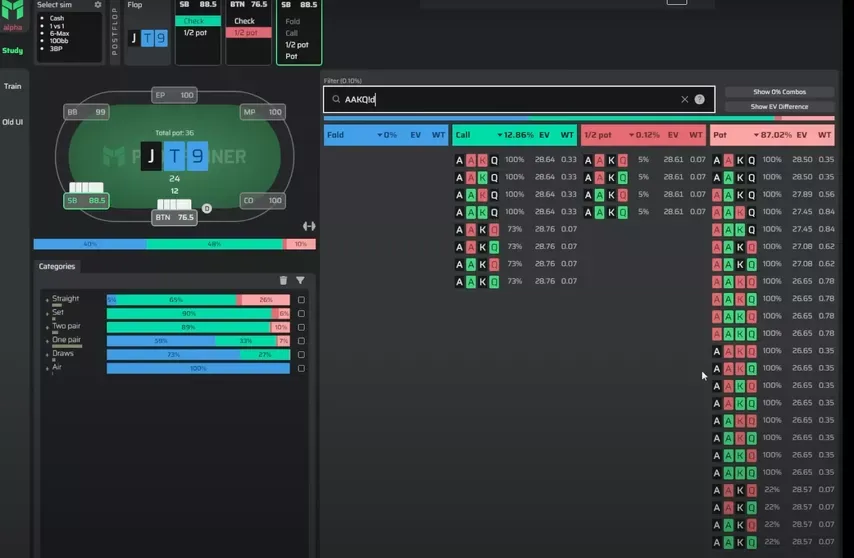
Solver also prefers to use the maximum raise sizing.
I raise to $218.90. The opponent goes all-in. I'm not thrilled, but what can you do.
He shows two pair with a flush draw, he has 53% equity. But we win both spins.
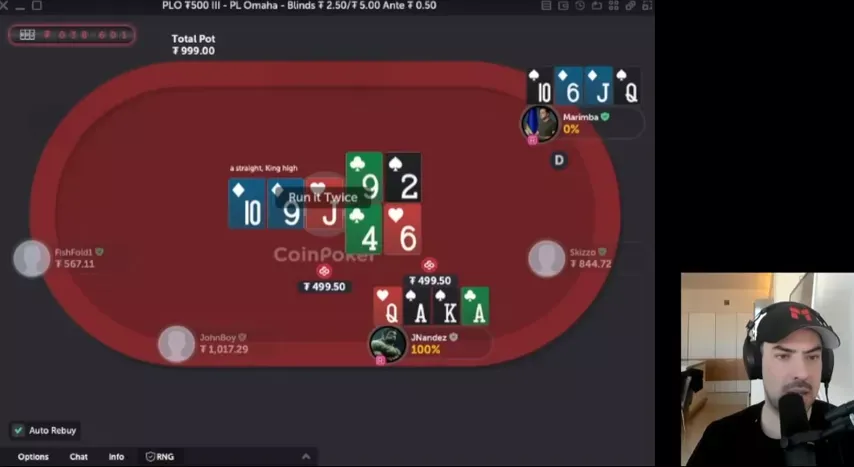
In the next hand we have some great aces again that we can 3-bet with.

Opponent calls. The flop comes . And here I made a mistake.
Both ranges hit the board very poorly (remember, Villain raised from second position), and I figured we could afford to bet the max and commit to the pot. Villain will often go all-in with a pair and a straight draw, and will often call with a weaker pair and backdoors.
I bet the pot, the opponent calls.
Turn ($139.68, effective stack $154.70):
A disastrous turn that can only be played check-fold.
I check, but the opponent checks after that, and on the river comes . For us, however, nothing has changed – our plans are still exclusively check-fold. I check and fold to a bet of half the pot.
And what will the solver say? On this straight texture on the flop he bets a third and on a very wide range, more than 80%. – a decent hand for drawing, gets a lot of calls from weaker hands.
On the previous street texture Both players had a lot of strong hands – nut straights, sets, two pairs, flush draws in all possible combinations. Therefore, the continuation bet range should be polar. A value bet requires a lot of strength. everything is different. There are few straights, almost no sets or two pairs. In my range, there are only 4.2% of them, while my opponent has 10.5%. But the fact that he has more nuts is not enough to force me to check on the flop, because these nuts are too few in absolute terms! In 90% of cases, he has one pair at best, and this pair is always weaker than our aces. Therefore, we bet a third and win against worse hands. And by the way, we do not fold to a raise.
Betting pot on the flop is a pretty big mistake, allowing our opponent to easily fold weak hands, preventing us from making a subtle play.
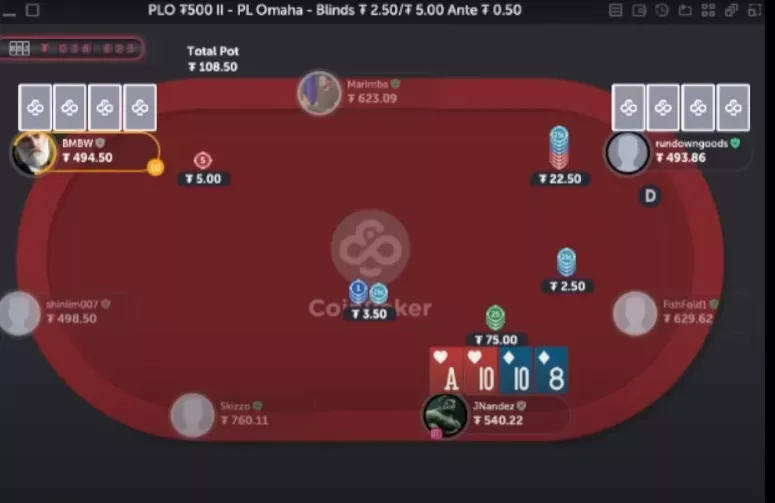
In the last hand of the day, I 3-bet after a limp and an isolator with a nice double-suited hand. This is a completely standard action that earns 1.04 bb each hand, the solver fully approves of it. The call wins about 0.5 bb – a huge difference, the call, although a plus decision, is a gross mistake!
The limper folds, the button calls.
Flop ($156):
A bad board for our range, huh? We don't really hit it, unlike the button. We have very few straights and sets, and even wraps are much less common for us than for our opponent. However, the SPR in this format – not after a regular raise and 3-bet, but after a limp, isolator and 3-bet – is already less than three, and we have pretty decent blockers – an eight blocks a top set and two pairs, and tens – a straight draw. In an all-in, two backdoor flush draws can help us out.
I ran a separate simulation in Monker to calculate a strategy for this SPR, and it turned out that we should be checking 86% of hands. However, with you can and should play more aggressively:
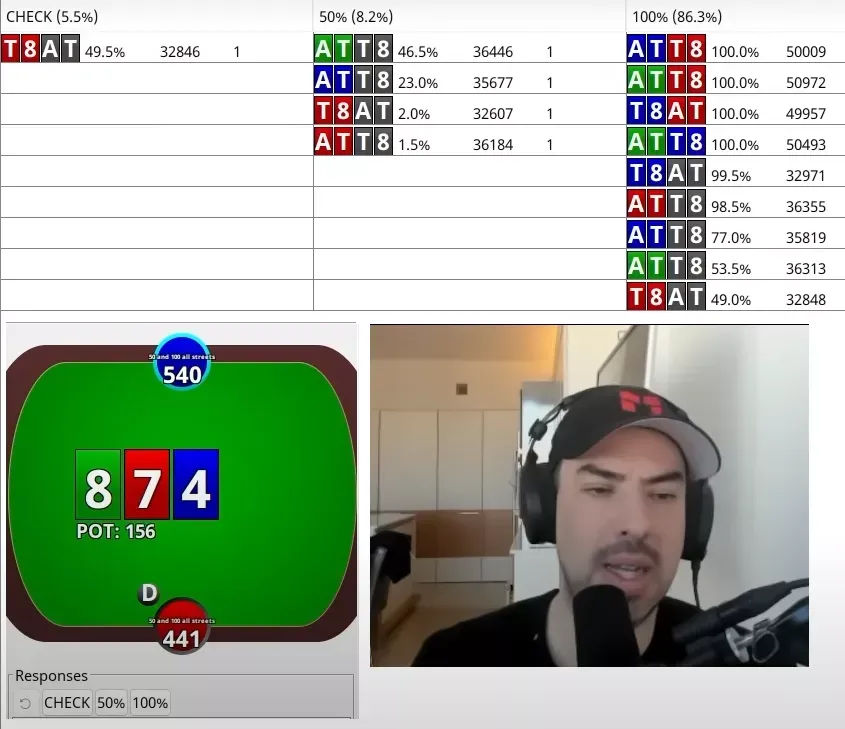
The rare combination of blockers and equity allows us to bet pot with this hand. And of course, the key factor in making this decision is the stack-to-pot ratio. In deep stacks or in a standard 3-bet pot, the optimal line may be different.
I put the pot in. Most often in this case we will see a fold, due to these folds we will show a plus. This time the opponent had a hand for a stackoff – he showed , two senior pairs.
Nevertheless, we had a whole 44% equity. Too bad it didn't get there.
I hope this session analysis was interesting. Until next time!
